As part of the Know Your Ingredients initiative, this post is written to highlight fashion industry regulations and apparel product knowledge. At &HER, we monitor fiber and chemical innovation, review policy and new regulations because it is our goal to offer you the most well designed garment for your body and our planet. We welcome your engagement to inquire, suggest, and critique our product. Please email hello@andher.us. Conversation is where improvement starts.
Scientists estimate that over 8 million tons of plastic enter our oceans each year. While we have all seen the plastic bottles, bags, and straws that contribute to the plastic pollution problem, one major source of plastic pollution is less obvious: our clothes.
When washed, synthetic clothing sheds tiny plastic fragments known as microfibers. Microfibers are the most prevalent type of microplastic (plastic pieces less than 5 mm in diameter) found in the environment. Though we cannot see them, plastic microfibers are all around us.
ORIGIN OF MICROFIBER
The majority of clothing on the planet is made from plastic-based materials like polyester, rayon, nylon, and acrylic. When washed, synthetic clothing sheds tiny plastic fragments known as microfibers. Microfibers are the most prevalent type of microplastic (plastic pieces less than 5 mm in diameter) found in the environment. Though we cannot see them, plastic microfibers are all around us. (epa article on microfiber)
Polyester is found in approximately 60 percent of garments on retail shelves today. That equates to approximately 21.3 million tons of polyester—a 157 percent increase between 2000 and 2015. These are worrying statistics when viewed through the sustainability lenses of production, use and disposal.
Polyester is a synthetic petroleum-based fiber, and is therefore made from a carbon-intensive non-renewable resource. Petroleum products are used as feedstock (raw material to make the fiber) and also used to generate the energy needed to manufacture. More than 70 million barrels of oil are used to make polyester each year. Polyester is not bio-degradable and will persist in the eco-system even as it eventually breaks apart. In fact, it is believed that synthetic garments are the biggest source of microplastic pollution in the oceans because up to 1900 fibers can be washed off one garment every time it is laundered.
WE EAT, DRINK & BREATHE MICROFIBERS
Plastic particles washed off from products such as synthetic clothes contribute up to 35% of the primary plastic that is polluting our oceans. Every time we do our laundry an average of 9 million microfibers are released into wastewater treatment plants that cannot filter them. Because of that, these fibers end up in the ocean. Also, just by wearing synthetic clothes, plastic fibers are constantly being released in the air. (oceancleanwash.org)
Recent research proves that we are eating and drinking plastic and that plastic fibers are literally raining down from the sky. We breathe in plastic microfibers from our clothing, carpets, curtains & other textiles.
video credit: the story of stuff project
ENERGY CONSUMPTION: SYNTHETIC FIBER vs. NATURAL FIBER
Although it is less energy intensive than nylon to produce, polyester still requires more than double the energy of conventional cotton to produce. The production of polyester uses harmful chemicals, including carcinogens, and if emitted to water and air untreated, can cause significant environmental damage. Most polyester is produced in countries such as China, Indonesia and Bangladesh where environmental regulations are lax, and air and water pollution is often discharged untreated, resulting in significant pollution and harm to communities in the vicinity of (as well as downstream and downwind of) manufacturing plants. The water-intensity of production is much lower than for natural fibers. However, polyester cannot be dyed using low impact and natural dyes. This means that the detrimental impact on water supplies is potentially far greater.
RECYCLED POLY (PET) IS NOT A Is Not a Solution for Sustainability in Fashion
Brands using recycled plastic in their collections love to say they are practicing a circular economy. However, circular economy, as its name implies, is a closed cycle where the recycled, reused or composted product becomes something of equal value in a continuous and uninterrupted sequence. But plastic fabrics, recycled or not, are not recycled at the end of their life. They end up in landfills because there is no large-scale recycling technology for post-consumer textiles.
WHAT CAN WE DO?
With small changes in your washing habits, you can reduce the number of fibers you shed. Here are a few suggestions from oceancleanwash.org
Use washing liquid instead of powder: the ‘scrub’ function of the grains of the powder results in loosening the fibers of clothes more than with liquid.
Use a fabric softener: some ingredients in fabric softeners reduce friction between fibers so the release decreases.

